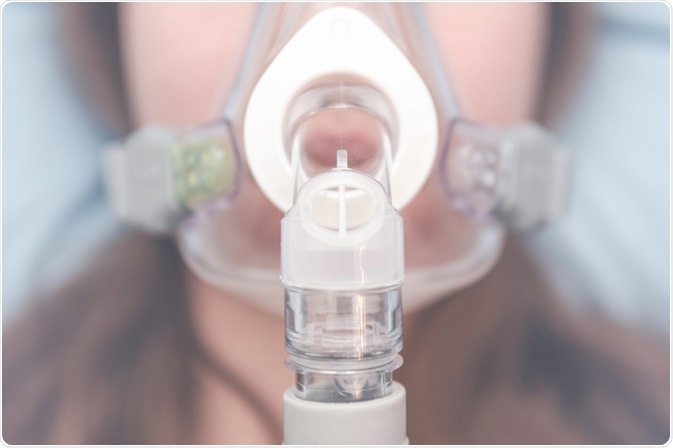Hypoxemia is defined as a condition where arterial oxygen tension or partial pressure of oxygen (PaO2) is below the normal value, which is typically between 80 and 100 mmHg.

Image Credit: AndrewFall / Shutterstock.com
Hypoxemia can develop as a result of one or more five main mechanisms:
- Ventilation-perfusion mismatch
- Diffusion impairment
- Alveolar hypoventilation
- Right to left shunt
- Diffusion-perfusion abnormality
Ventilation-perfusion mismatch
Alveolar ventilation is normally between four and six liters per minute. This physiological process is responsible for bringing oxygen to and removing carbon dioxide from the lungs.
Mixed venous blood carries carbon dioxide into the lungs and takes up alveolar oxygen. The alveolar partial pressures of oxygen and carbon dioxide are therefore determined by the relationship between alveolar ventilation and perfusion.
An ideal ratio of ventilation to perfusion, which is also known as the V/Q ratio, is approximately one. If this ratio is less than one, but not zero, hypoxemia caused by this mechanism can develop. An abnormal V/Q ratio in various regions of the lungs is the most common cause of hypoxemia in all types of patients.
This type of hypoxemia is also common in advanced liver disease due to cirrhosis and hepatic hydrothorax. It responds beneficially to oxygen supplementation given either by face mask or nasal prongs. If the response to provided oxygen is poor, it suggests the existence of a severe diffusion-perfusion abnormality or a shunt.
Diffusion impairment
Oxygen diffuses passively from the alveoli into the pulmonary capillaries. In healthy individuals, the transit time for erythrocytes in the pulmonary capillaries exceeds the time required for the partial pressure of oxygen in the mixed venous blood to achieve equilibrium with the alveolar gas.
Inflammatory conditions that result in both an accumulation of different cells and edema between the alveoli and capillaries can alter the adequate movement of oxygen. The development of fibrosis and granulomas can make the condition even worse. The end result is a reduction in the partial pressure of oxygen and the rise of hypoxemia.
Hypoxemia due to diffusion impairment improves with an increased fraction of inspired oxygen and can be quantified by the classic pulmonary function test also known as diffusing capacity of the lung for carbon monoxide (DLCO).
Alveolar hypoventilation
In the circumstances of low alveolar ventilation, an insufficient amount of oxygen is delivered to the alveoli each minute. This can result in hypoxemia even when the function of the lungs is preserved, as the cause of the condition is often somewhere else. The partial pressure of oxygen is normal, but hypercapnia, which is defined as an increased amount of carbon dioxide, often ensues.
Some of the causes of such hypoventilation include depression of the central nervous system by drugs, inflammation or hemorrhage in the brainstem, abnormal spinal cord pathway, disease of the motoneurons or nerves supplying the respiratory muscles, disease of the neuromuscular junction, disease of the respiratory musculature, an abnormality of the chest wall, as well as obstruction of the upper airways.
Hypoventilation and Hyperventilation - EMTprep.com
Right to left shunt
In essence, right to left shunt represents an extreme version of ventilation-perfusion mismatch, where practically no ventilation is going to the regions of perfused lungs. As a result, the V/Q ratio is zero. The shunt can be intracardiac or intrapulmonary and results in severe hypoxemia.
The principal clinical feature of a right to left shunt is that the resulting hypoxemia cannot be corrected with the supplementation of oxygen. This is because the shunted blood is not exposed to the administered oxygen, thus lowering the overall partial pressure of oxygen.
However, if the shunt itself is relatively small, administering supplemental oxygen can act as a remedy for its low partial pressure. For this reason, supplemental oxygen is always given to patients with this type of hypoxemia, regardless of the underlying pathophysiologic mechanism.
Diffusion-perfusion abnormality
A diffusion-perfusion abnormality is most frequently associated with hepatopulmonary syndrome. More specifically, there is limited diffusion through dilated precapillary and capillary blood vessels with rapid perfusion of venous blood through such abnormal vasculature that is directly connected to gas exchange units.
Even though severe hypoxemia can ensue from breathing room air, inhalation of 100% oxygen can dramatically improve the partial pressure in the blood, although not for all patients. The oxygen problem can become worse as the affected individual moves to a standing position, due to an increase in gravitational blood flow through dilated vessels in the lung bases.
In conclusion, measuring hemoglobin saturation through finger pulse oximetry while the patient is breathing room air in the standing position is a reliable and inexpensive way of screening for significant hypoxemia. Assessing the amount of available oxygen for the peripheral tissues represents a crucial step in the management of all patients who are at risk of respiratory dysfunction.
References
Further Reading
Last Updated: Dec 22, 2022